| Srl | Item |
| 1 |
ID:
119129
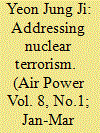

|
|
|
| 2 |
ID:
055534
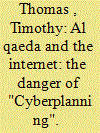

|
|
|
| 3 |
ID:
094537
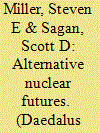

|
|
|
| 4 |
ID:
023305
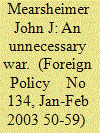

|
|
|
|
|
| Publication |
Jan-Feb 2003.
|
| Description |
50-59
|
|
|
|
|
|
|
|
|
|
|
|
|
|
|
|
| 5 |
ID:
146720
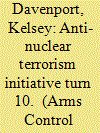

|
|
|
| 6 |
ID:
110874
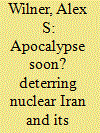

|
|
|
|
|
| Publication |
2012.
|
| Summary/Abstract |
The arguments presented here are based on a future scenario in which Iran has succeeded in developing nuclear weapons. Employing the logic and theory of deterrence, the article suggests ways in which the United States and its allies might counter, contain, and coerce nuclear Iran's sponsorship of terrorism and nonstate militant groups. Four strategic concerns are explored in particular: nuclear Iran may blackmail rival and neighboring states; shield an especially assertive foreign policy; protect its nonstate proxies and protégés; and facilitate nuclear terrorism. Deterrence theory is applied to each scenario.
|
|
|
|
|
|
|
|
|
|
|
|
|
|
|
|
| 7 |
ID:
079349
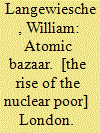

|
|
|
|
|
| Publication |
London, Allen Lane, 2007.
|
| Description |
179p.
|
| Standard Number |
9781846140112
|
|
|
|
|
|
|
|
|
|
|
|
Copies: C:2/I:0,R:0,Q:0
Circulation
| Accession# | Call# | Current Location | Status | Policy | Location |
| 052608 | 355.825119/LAN 052608 | Main | On Shelf | General | |
| 053113 | 355.825119/LAN 053113 | Main | On Shelf | General | |
|
|
|
|
| 8 |
ID:
103228
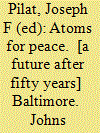

|
|
|
|
|
| Publication |
Baltimore, Johns Hopkins University Press, 2007.
|
| Description |
xix, 364p.
|
| Standard Number |
9780801885617, hbk
|
|
|
|
|
|
|
|
|
|
|
|
Copies: C:1/I:0,R:0,Q:0
Circulation
| Accession# | Call# | Current Location | Status | Policy | Location |
| 055892 | 327.1747/PIL 055892 | Main | On Shelf | General | |
|
|
|
|
| 9 |
ID:
107063
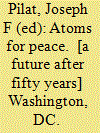

|
|
|
|
|
| Publication |
Washington, DC, Woodrow Wilson Center Press, 2007.
|
| Description |
xix, 364p.
|
| Standard Number |
9780801885617
|
|
|
|
|
|
|
|
|
|
|
|
Copies: C:1/I:0,R:0,Q:0
Circulation
| Accession# | Call# | Current Location | Status | Policy | Location |
| 056207 | 327.1747/PIL 056207 | Main | On Shelf | General | |
|
|
|
|
| 10 |
ID:
082597


|
|
|
| 11 |
ID:
160569
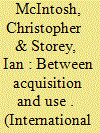

|
|
|
|
|
| Summary/Abstract |
Much of the contemporary literature on nuclear terrorism focuses on the question of whether a terrorist organization could acquire a nuclear weapon. This assumes that once a terrorist group acquires a weapon, they will, at some point, attempt to detonate it in an attack. This article calls that assumption into question by using a strategic perspective to examine the likely behavior of a nuclear-armed terrorist organization. We identify and assess the most likely options available and conclude that a nuclear terrorist attack is the least likely outcome—even for terrorist groups with nuclear capability. This results from three drawbacks of actually detonating a nuclear weapon: the costs associated with an attack, the benefits forfeited in terms of the options foreclosed by using the weapon, and the relative strategic value of alternative courses of action.
|
|
|
|
|
|
|
|
|
|
|
|
|
|
|
|
| 12 |
ID:
079568
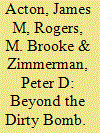

|
|
|
| 13 |
ID:
183002
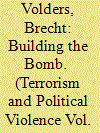

|
|
|
|
|
| Summary/Abstract |
A terrorist organization constructing and detonating a nuclear device is often a topic of popular, academic, and political concern. Yet, assessing this risk is a challenging task. This article aims to contribute to the encompassing nature of any future nuclear terrorism threat assessments by further exploring the often overlooked organizational dimension in probability assessments on nuclear terrorism. Particular emphasis is given to the role of the organizational design. In order to do so, this article theoretically builds on a 2017 research article and empirically studies Aum Shinrikyo’s chemical and biological armament activities. This article confirms and further refines the idea of an effectiveness-efficiency trade-off for a terrorist organization implementing a nuclear armament project. It particularly zooms in on the constraints that follow from the covert nature of this type of plot and elaborates on the role of Aum Shinrikyo’s value-rationality.
|
|
|
|
|
|
|
|
|
|
|
|
|
|
|
|
| 14 |
ID:
020448
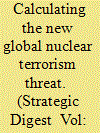

|
|
|
|
|
| Publication |
Nov 2001.
|
| Description |
1485-1488
|
|
|
|
|
|
|
|
|
|
|
|
|
|
|
|
| 15 |
ID:
054624
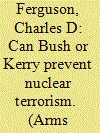

|
|
|
| 16 |
ID:
080147
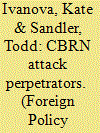

|
|
|
|
|
| Publication |
2007.
|
| Summary/Abstract |
Based on zero-inflated negative binomial regressions applied to the Monterey weapons of mass destruction data, this article assesses the future risks from chemical, biological, radiological, and nuclear (CBRN) terrorism. Once the threshold for CBRN attacks is surpassed, further attacks arise: the expected number of CBRN incidents is over one and a half times higher than past events. Religious cults and groups with a transnational orientation pose the largest CBRN threat to society. Other things constant, nationalists/separatists and religious fundamentalists are not more apt to engage in CBRN terrorism than compared to "other groups." Democratic and corrupt regimes are the likely venues for CBRN incidents. Based on past incidents, rich countries are especially vulnerable to CBRN terrorism. Thus, recent actions by the U.S. Department of Homeland Security to put more resources into guarding against CBRN attacks appear sound. This study indicates that nonfundamentalist terrorists also present CBRN risks to democracies. From a foreign policy viewpoint, CBRN terrorism is not a problem that rich democratic countries can confront alone, because the terrorists will move to where there is the least vigilance. Our study indicates the likely perpetrators and types of attacks that nations must cooperate to avoid
|
|
|
|
|
|
|
|
|
|
|
|
|
|
|
|
| 17 |
ID:
171539
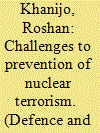

|
|
|
| 18 |
ID:
137502
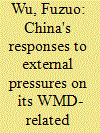

|
|
|
|
|
| Summary/Abstract |
China, although a member of most of the international non-proliferation and multilateral export control regimes and having a law-based comprehensive export control system, has not fully complied with its non-proliferation obligations, which is evidenced by not only the US's sanctions on some Chinese entities for their weapons of mass destruction (WMD) related exports but also some external disclosures in this regard. Faced with these external pressures, China's responses have been both reactive and proactive. The rationale for China's mixed responses can be attributed to its security interest in preventing nuclear terrorism, geopolitical interests in South Asia, economic interests in procuring oil supplies, high-tech imports and missile export markets, in addition to its status interest in building a ‘responsible great power’ identity in the international community.
|
|
|
|
|
|
|
|
|
|
|
|
|
|
|
|
| 19 |
ID:
049734
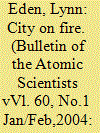

|
|
|
|
|
| Summary/Abstract |
For decades war planners have ignored the fire damage that would result from a nuclear attack. By counting blast damage alone, they could demand a far larger nuclear arsenal
|
|
|
|
|
|
|
|
|
|
|
|
|
|
|
|
| 20 |
ID:
166864
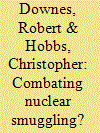

|
|
|
|
|
| Summary/Abstract |
International concern over nuclear terrorism has grown during the past few decades. This has driven a broad spectrum of efforts to strengthen nuclear security globally, including the widespread adoption of radiation-detection technology for border monitoring. Detection systems are now deployed at strategic locations for the purported purpose of detecting and deterring the smuggling of nuclear and radioactive materials. However, despite considerable investment in this area, few studies have examined how these programs are implemented or the operational challenges they face on a day-to-day basis. This article seeks to address this with a focus on radiation-detection efforts at maritime facilities. Utilizing practitioner interviews and a survey, this article identifies the factors that influence the planning and use of these systems in this fast-moving environment. The results clearly demonstrate that the implementation of these systems varies significantly across different national and organizational contexts, resulting in a fragmented global nuclear-detection architecture, which arguably undermines efforts to detect trafficked nuclear-threat materials. Greater consideration should therefore be given to developing international standards and guidance, designing and adopting tools to support key parts of the alarm assessment process, and broader sharing of good practice.
|
|
|
|
|
|
|
|
|
|
|
|
|
|
|
|